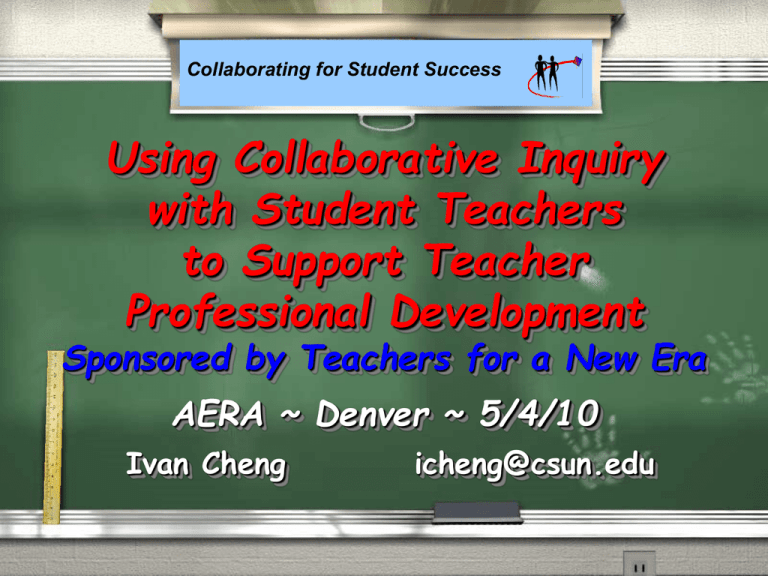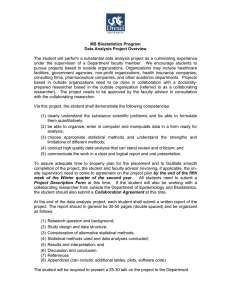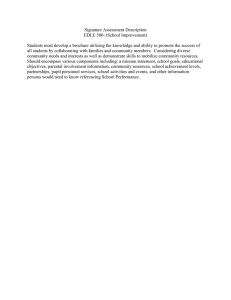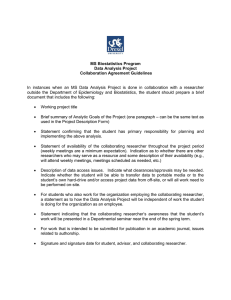AERA PowerPoint (5/4/10)
advertisement

Collaborating for Student Success Using Collaborative Inquiry with Student Teachers to Support Teacher Professional Development Sponsored by Teachers for a New Era AERA ~ Denver ~ 5/4/10 Ivan Cheng icheng@csun.edu Collaborating for Student Success The Problem • • • Algebra success rate is low in the district Only 6% of 828 Algebra 1 students at one high school scored “Proficient” or above in on the California Standards Test (CST) Two thirds of those who fail Algebra in 8th or 9th grade fail to graduate on time Collaborating for Student Success The Solution “To improve their mathematics instruction, teachers must be able to analyze what they and their students are doing and consider how those actions are affecting students’ learning.” NCTM Principles and Standards, p. 18 Collaborating for Student Success The Solution ”Teachers learn well just as students do – by studying, doing, and reflecting; by collaborating with other teachers; teachers by looking closely at students and their work; and by sharing what they see.” Darling-Hammond (1999), p. 12 Collaborating for Student Success Theoretical Framework • • Learning environment needed to support generative change (Darling-Hammond, et al. 2009; Ball, 2002; Swafford, et al. 1999; Chapin, 1994; Little, 1993; Lave & Wenger, 1991) Practical inquiry around student thinking similar to CGI (Carpenter, et al. 2000; Franke, et al. 2001; Carpenter, et al., 1999) Collaborating for Student Success Theory of Change Traditional Model Professional Development Teacher Learning Student Achievement Collaborating for Student Success Theory of Change Student Centered Model Collaborative Inquiry Student Achievement Collaborating for Student Success Theory of Change Student Centered Model Professional Development Collaborative Inquiry Student Achievement Teacher Learning Collaborating for Student Success The Intervention • • • • Student Improvement Through Teacher Empowerment (SITTE) Utilize teachers’ classrooms as “laboratories” for daily practical inquiry Collaborative inquiry based on the Cognitively Guided Instruction (CGI) model The Responsive Teaching Cycle (RTC) Collaborating for Student Success Responsive Teaching Cycle (RTC) • Daily collaboration around evidence of student learning Explore Establish • Student Learning Experiment Examine Focus on getting through to students rather than getting through a book Collaborating for Student Success Participants • • The Study 4 Teachers (9 sections of Algebra 1, almost all with past failure in math) 5 Student Teachers (theater arts, food science, political science, engineering, math) Collaborating for Student Success The Study Research questions • Impact on teachers’ decisions & practice • Impact on students’ performance Data • Lesson activities (Hiebert et al., 2003) • Online reflections & emails • Meeting notes Collaborating for Student Success The PACT Framework • • • • Four tasks: Planning Planning, Instructing, Assessing, Reflecting (+ attention to Academic Language) Similar to National Board process Artifacts and commentaries, including video of teaching Valid and reliable assessment; scorers calibrated Collaborating for Student Success The Planning Task • • • Balanced focus: Connections between procedures, concepts, reasoning Access to content: Sequencing of tasks, structured supports for learning Meaningful assessments: Aligned with opportunities to engage in mathematics; rich problems to elicit levels of understanding Collaborating for Student Success Impact on Teachers • • • • Basic skills developed in context, not in isolation Multiple representations used to provide meaningful connections Critical thinking promoted through patterns and explorations Focused on teaching tools instead of teaching topics Collaborating for Student Success Impact on Teachers Collaborating for Student Success Impact on Teachers Noe wants to get an A in his Algebra 1 class. He has decided that the first thing he needs to do to get an A in his math class is to attend class every day. Each day that Noe comes to class he earns 5 points. 1. Answer the questions below: a. If Noe comes to class for 2 days, how many points does he have? b. If Noe comes to class for 8 days, how many points does he have? c. If Noe comes to class for 12 days, how many points does he have? d. If Noe comes to class for 15 days, how many points does he have? e. If Noe comes to class for 18 days, how many points does he have? 2. Describe what you did to get your answers for a–e. 3. Complete the table below: 4. Choose a letter to represent the number of days that Noe attends school. Use that letter to write an expression that represents the number of points that Noe earns when he attends class. 5. Draw a graph on the back. 6. If Noe went to school for 132 days, how many points will he earn? 7. If Noe earned 55 points, how many days did he attend class? Collaborating for Student Success Impact on Students The installation cost and monthly monitoring fee of a security system are listed below for two companies. Ace Systems charges $327 for installation and $204 per month for monitoring the system. Zero Entry charges $535 for installation and $188 per month for monitoring the system. • Write a variable expression for the total cost of a security system installed and monitored by Ace Systems. Write a variable expression for the total cost of a security system installed and monitored by Zero Entry. Define the variable. • Mrs. Clark will sign a contract to have a security system installed and monitored for 12 months. Calculate the total cost each company will charge for this service. Show all your work. • If Mrs. Clark signs a contract to have a security system installed and monitored for 18 months, which company has a lower total cost? Provide an explanation or show all your work. Collaborating for Student Success Impact on Students Overall (% Correct) Mult. Choice (# Correct) 45 8 40 2.5 7 35 2 6 30 5 25 School 20 1.5 SITTE 3 2 10 School School 4 SITTE 15 SITTE 1 0.5 1 5 0 Constructed Resp. (4 Max.) Unit 1 Unit 2 Unit 3 0 0 Unit 1 Unit 2 Unit 3 Unit 1 Unit 2 Unit 3 Collaborating for Student Success Limitations • • • • Participants were not randomly selected (though the students were) The role of the facilitator was not examined Constructed response items were scored by the teachers themselves Mathematics learning of teachers, MKT, and tacit beliefs were not assessed Collaborating for Student Success Implications • • • Students benefit from the collaboration of their teachers Teacher learning can occur when educational settings are structured to focus on student learning Student teachers can gain experience enacting the practices that are promoted in their pre-service courses Collaborating for Student Success Thank You AERA Conference Denver ~ 5/4/10 Ivan Cheng icheng@csun.edu Collaborating for Student Success



